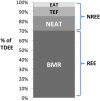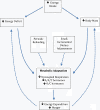Metabolic adaptation to weight loss: implications for the athlete
- PMID: 24571926
- PMCID: PMC3943438
- DOI: 10.1186/1550-2783-11-7
Metabolic adaptation to weight loss: implications for the athlete
Abstract
Optimized body composition provides a competitive advantage in a variety of sports. Weight reduction is common among athletes aiming to improve their strength-to-mass ratio, locomotive efficiency, or aesthetic appearance. Energy restriction is accompanied by changes in circulating hormones, mitochondrial efficiency, and energy expenditure that serve to minimize the energy deficit, attenuate weight loss, and promote weight regain. The current article reviews the metabolic adaptations observed with weight reduction and provides recommendations for successful weight reduction and long term reduced-weight maintenance in athletes.
Figures


References
-
- Rossow LM, Fukuda DH, Fahs CA, Loenneke JP, Stout JR. Natural bodybuilding competition preparation and recovery: a 12-month case study. Int J Sports Physiol Perform. 2013;8:582–592. - PubMed
-
- Deutz RC, Benardot D, Martin DE, Cody MM. Relationship between energy deficits and body composition in elite female gymnasts and runners. Med Sci Sports Exerc. 2000;32:659–668. - PubMed
LinkOut - more resources
Full Text Sources
Other Literature Sources
Medical
